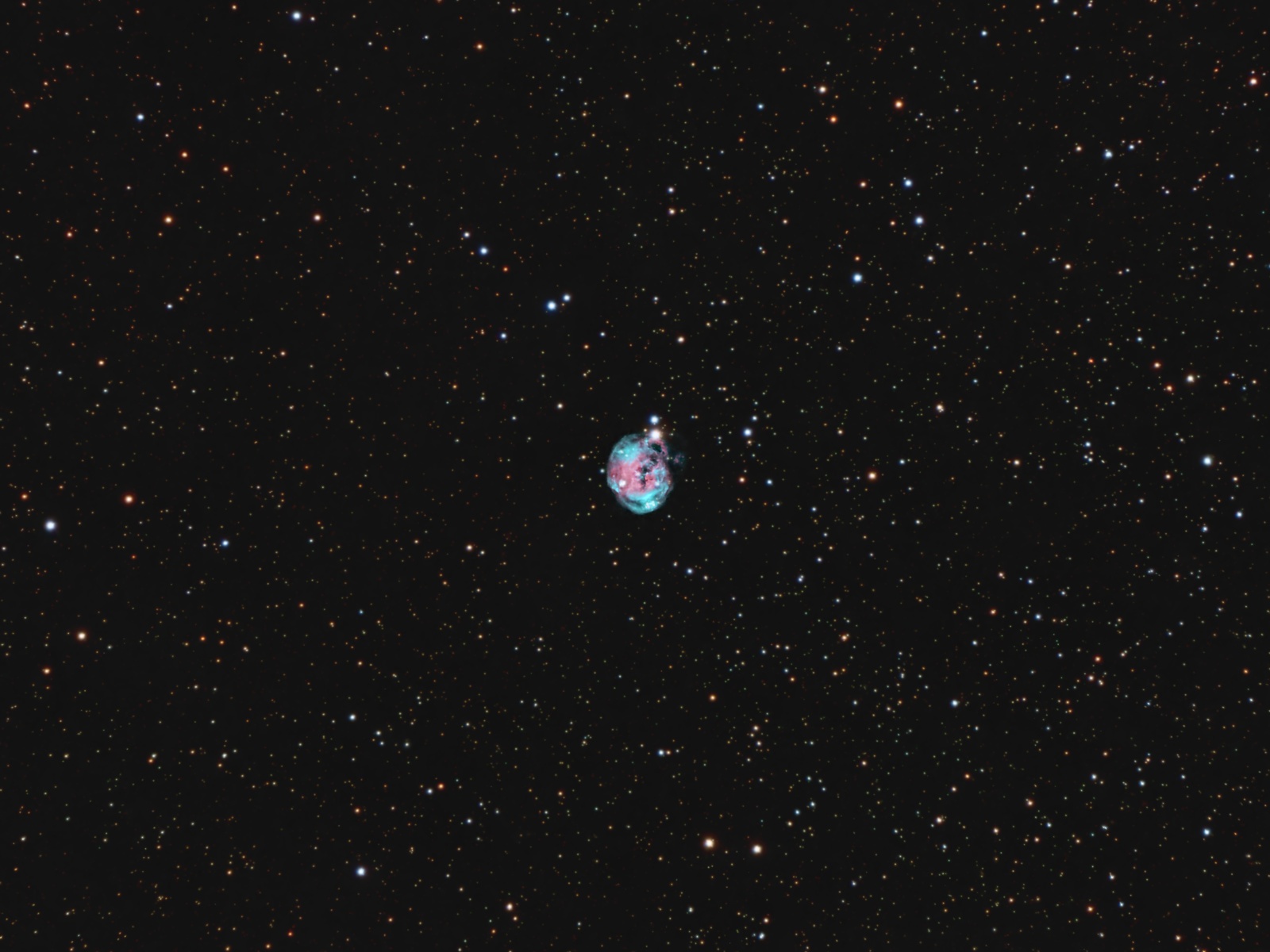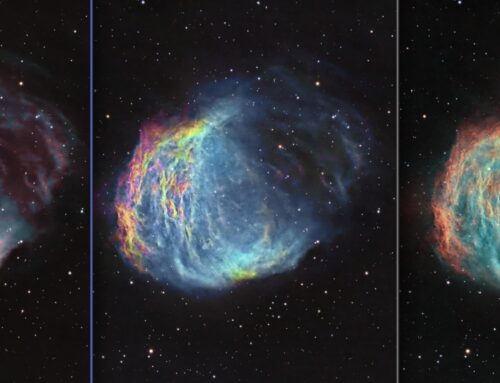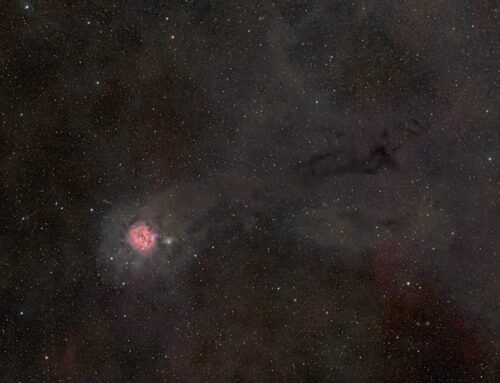NGC 7008
Click image for full size version
September 3, 2023
NGC 7008 is a planetary nebula in Cygnus. It is very small in our sky, measuring just 1.4′ x 1.1′. In reality, it is about 1 light year across. This is a nebula formed around a dying star, similar to M57, the Ring Nebula. The teal colour comes from oxygen emissions and the red tones come from hydrogen.
Tekkies:
Acquisition, focusing, and control of Paramount MX mount with N.I.N.A., TheSkyX and PHD2. Primalucelab low-profile 2″ Esatto focuser and ARCO rotator. Equipment control with PrimaLuce Labs Eagle 4 Pro. All pre-processing and processing in PixInsight. Acquired from my SkyShed in Guelph. Average transparency and seeing. Data acquired August 31 to September 3, 2023 under a nearly full Moon.
Celestron 14″ F/11 EDGE HD telescope at f/11 (3,912 mm focal length) and QHY600M camera binned 2×2 with Optolong filters.
8x5m Red = 0hr40m
8x5m Green = 0hr40m
8x5m Blue = 0hr40m
58x5m Ha = 4hr50m
47x5m O3 =3hr55m
Total: 10hr45m
Preprocessing: The WeightedBatchPreProcessing script was used to perform calibration, cosmetic correction, weighting, registration, local normalization and integration of all frames.
Colour master: A colour master was made from the Red, Green and Blue masters using ChannelCombination in RGB mode.
Gradient Removal: DynamicBackgroundExtraction was applied to the RGB, Ha and O3 masters.
Colour Calibration: ColorCalibration was used to calibrate the RGB master.
Deconvolution: BlurXterminator was used on the Ha, O3 and RGB masters with Automatic psf , and star sharpening set to 0.10 with “Correct First” selected.
Linear Noise Reduction: NoiseXterminator was applied to the Ha, O3 and RGB masters with settings Amount=0.9 and Detail=0.25
Star Removal: StarXterminator was used to remove the stars from each of the Ha, O3 and RGB masters, with default settings.
Stretching: HistogramTransformation was applied to the Ha, O3 and RGB masters to make pleasing images. Approximate background level after stretch was 0.10 for RGB and 0.08 for Ha and O3.
Nonlinear Processing
Addition of Ha: PixelMath was used to blend Ha into the RGB image using the following expression with parameter values a=1 and b=0.06.
Red: max($T[0], a*Ha)
Green: $T[1]
Blue: iif($T[0]<a*Ha, $T[2] + b * Ha, $T[2])
Addition of O3: PixelMath was used to blend O3 into the HaRGB image using the following expression with parameter values a=0.55. A mask was used to provide some protection to the red regions in the centre of the nebula.
Red: $T[0]
Green: max($T, a*O3)
Blue: max($T, a*O3)
Nonlinear Noise Reduction: NoiseXterminator was used to reduce noise in the background areas of the image with settings Amount=0.9 and Detail=0.2
Re-stretch: HistogramTransformation was used to boost contrast by moving the dark point to the toe of the histogram and slightly decreasing the mid-point slider.
Contrast Enhancement: LocalHistogramEqualization was applied three times using a mask to select the nebula. A Contrast Limit of 1.5 and 1 iteration was used for each LHE application (scale 20, strength 0.35; scale 50, strength 0.25; scale 100, strength 0.2).
Sharpening: The same mask was used for sharpening with MultiscaleMedianTransform (Layers 1 – 5 with strengths of 0.01, 0.03, 0.05, 0.03, and 0.01, respectively). UnsharpMask was applied through the same mask (Std Dev=2.2; amount=0.7; target= RGB/K components; dark deringing=0.03; bright deringing=0.004).
Stars-only steps: MorphologicalTransformation was used in Morphological Selection mode to shrink the stars through a mask made by extracting the Luminance from the stars-only image. CurvesTransformation was used to add saturation to the stars.
Star Restoration: PixelMath expression combine(starless, stars, op_screen()) was used to combine the starless and stars-only images created with StarXterminator. A mask was used to slightly reduce stare addition in the brightest parts of the nebula.
Final Steps: Background, nebula and star brightness, contrast and saturation were adjusted in several iterations using CurvesTransformation with masks as required. ICCProfileTransformation (sRGB IEC61966-2.1; Relative Colorimetric with black point compensation) was applied prior to saving as a jpg. The finder chart was made using the FindingChart process.








Leave A Comment